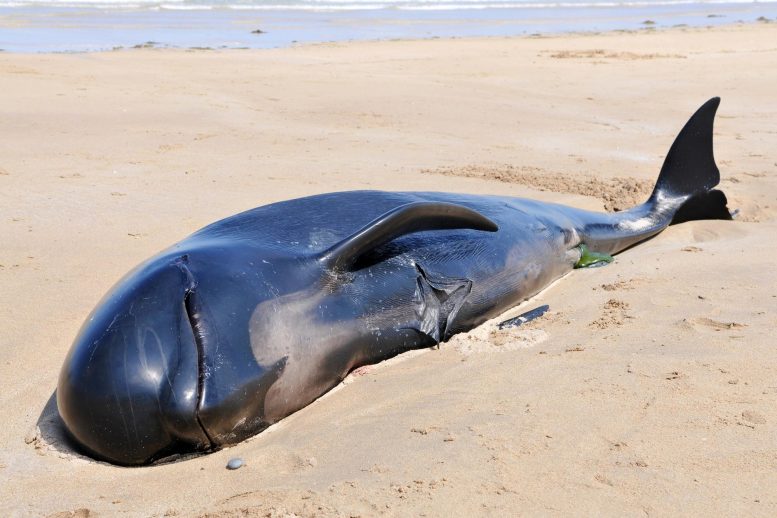
Stock photo of a beached pilot whale carcass.
A new study published by the open access publisher Frontiers shows the usefulness of opportunistically collected specimens, such as stranded carcasses, to study elusive species. The researchers used stable isotope analysis of skin, muscle, and bone tissue of Sowerby’s beaked whales to study their spatial ecology. They found that the species exhibits both short- and long-term habitat fidelity. The results are published in Frontiers in Conservation Science and show the importance of such studies for marine wildlife conservation.
A mysterious whale species
Beaked whales, a species of toothed whales, make up more than 25% of extant cetaceans (dolphins, porpoises, and whales), but are elusive and notoriously difficult to study. They live in deep waters and stay away from shores. Due to a lack of observations from the wild, little is known about their ecology and biology. Because of this, they are considered ‘data deficient’ by the IUCN Red List and developing conservation plans is challenging.
Some species of beaked whales have never been observed alive and are only known from stranded carcasses. “Beaked whales are really cool, but most people haven’t heard of them because they are so enigmatic. Whales are generally large and charismatic — we can go on whale watching trips and see them in the wild, yet there are entire groups of whale species we know almost nothing about,” says Dr. Kerri Smith, of the University of Texas El Paso and the Smithsonian National Museum of Natural History, United States.
Sowerby’s beaked whales (Mesoplodon bidens) were first described more than 200 years ago, yet little is known about this species. The species’ geographic range is thought to cover much of the North Atlantic Ocean. Stranded animals have been collected from both North American and European waters, but it is unknown if the species is structured into spatially separate subpopulations or if there is one continuous and highly mobile population.
Stable isotope analysis to study elusive animals
Stable isotopes get incorporated into different tissue types through diet. The rate at which stable isotopes get incorporated into a tissue depends on the tissue’s growth and replacement rates. For example, skin turnover rates are faster than those of muscle, which in turn are faster than the turnover of bone. Stable isotope analysis is an efficient tool that can be used when traditional techniques, such as GPS tracking and camera recording from field observations, can’t be applied. It can be used to answer ecological and biological questions about a species’ diet or spatial origin across time.
To better understand the species’ spatial range, the researchers measured the carbon isotope (δ13C) and nitrogen isotope (δ15N) composition of skin, muscle, and bone tissue of Sowerby’s beaked whales from the east and west Atlantic. The 102 samples were collected from museum specimens, stranded carcasses, and bycaught animals, and included females and males from all ages.
A treasure trove of data
When researchers work with specimens of opportunity, there is little control over how samples were collected. “In our study, the majority of our specimens came from strandings and fisheries bycatch; since these specimens represent only a small portion of all Sowerby’s beaked whales, we only have a few pieces of a large, complex puzzle. Those pieces can tell us a lot, however, and the more we study these whales, the more we will learn about their distributions, behavior, and lives.”
The results show that there are at least two subpopulations of Sowerby’s beaked whales, one each in the eastern and western Atlantic. “Our study has two major results. First, it demonstrates the power of specimens of opportunity to answer fundamental ecological questions — these specimens are treasure troves of data waiting for someone to query them,” says Smith. “Second, it provides some of the first data about Sowerby’s beaked whale long-term distribution and population structure, something that would be nearly impossible to learn by studying living whales in their habitat. We can learn a lot about beaked whale ecology from specimens of opportunity.” The researchers suggest genetic analysis to explore possible genetic differentiation between the two populations.
The findings have implications for marine wildlife conservation. The two populations found here likely have different conservation needs. Smith concludes: “A key action to take going forward is generating more fundamental data through studies like this one — successful conservation action requires a strong foundation of reliable data, and there is still so much we do not know about beaked whales and many other marine species. As we learn more about them and their habitats, we may need to set aside important habitats as marine protected areas. Additional research to identify the potential influence of fishing activities and naval sonar on critical beaked whale habitats is also needed.”
Reference: “Stable Isotope Analysis of Specimens of Opportunity Reveals Ocean-Scale Site Fidelity in an Elusive Whale Species” by Kerri J. Smith, Clive N. Trueman, Christine A. M. France, Jed P. Sparks, Andrew C. Brownlow, Michael Dähne, Nicholas J. Davison, Guðmundur Guðmundsson, Kamal Khidas, Andrew C. Kitchener, Bram W. Langeveld, Véronique Lesage, Hanneke J. M. Meijer, John J. Ososky, Richard C. Sabin, Zena L. Timmons, Gísli A. Víkingsson, Frederick W. Wenzel and Markus J. Peterson, 28 May 2021, Frontiers in Conservation Science.
DOI: 10.3389/fcosc.2021.653766









Be the first to comment on "Scientists Use Whale Carcasses to Help Answer Mysteries of Elusive Species"